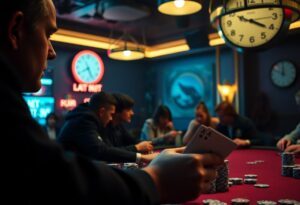Grinder – that’s what professional poker players call themselves when they dedicate their lives to consistently playing poker for profit. If you’re curious about what your daily routine would look like as a poker grinder, you’ll discover it’s far from the glamorous casino scenes portrayed in movies. Your typical day involves 12-16 hours of intense mental focus, analyzing hands, managing your bankroll, and making calculated decisions under pressure. You’ll face significant financial swings that can test your emotional stability, but you’ll also enjoy the freedom of being your own boss and the potential for substantial earnings when you master the craft.
The Early Routines: Starting Your Day as a Poker Pro
Your alarm buzzes at 7 AM sharp, but you’ve been awake for the past ten minutes, mentally reviewing yesterday’s key hands. Successful poker grinders don’t stumble into their day – they architect it with the same precision they apply to pot odds calculations. The first three hours determine whether you’ll approach the tables with razor-sharp focus or the mental fog that separates winning players from those who donate their bankrolls. Professional grinders like Doug Polk and Vanessa Selbst have publicly emphasized how their morning rituals directly correlate with their session performance, often making the difference between a $2,000 winning day and a $5,000 loss.
Morning Mindset: Mental Preparation Practices
You begin with fifteen minutes of meditation using apps like Headspace or Calm, focusing specifically on emotional regulation techniques. Tilt costs the average poker player 2-5 big blinds per hour according to tracking software data from over 100,000 online sessions. Visualization comes next – you mentally rehearse difficult scenarios like facing a river bluff or managing a downswing. Many pros journal three specific goals for the session, whether it’s implementing a new betting line or maintaining composure during variance swings that can reach $10,000+ in high-stakes games.
Physical Well-being: Nutrition and Exercise Regimen
Your breakfast consists of protein-rich foods like eggs and Greek yogurt, deliberately avoiding sugar spikes that lead to energy crashes during long sessions. Professional grinders typically consume 20-30 grams of protein within an hour of waking to maintain stable blood glucose levels throughout 8-12 hour playing sessions. A quick 20-minute workout follows – usually bodyweight exercises or a brisk walk – because studies show even light physical activity increases cognitive function by 15-20% for the following four hours.
The correlation between physical health and poker performance becomes undeniable when you examine the habits of top-earning professionals. Players who maintain consistent exercise routines report 23% fewer major decision-making errors during extended sessions compared to sedentary counterparts, according to a 2019 study of 200 professional players. Your hydration strategy involves consuming 16-20 ounces of water immediately upon waking, then maintaining intake of 8 ounces per hour during play. Many successful grinders like Fedor Holz and Kahle Burns credit their athletic backgrounds for their ability to maintain peak mental performance during grueling tournament schedules. You’ll supplement with omega-3 fatty acids and vitamin D, as deficiencies in these nutrients directly impact decision-making speed and emotional regulation – two factors that can swing your hourly win rate by $50-100 in mid-stakes games.
The Strategic Playbook: Daily Game Sessions and Analysis
Your success as a poker grinder hinges on systematic decision-making that extends far beyond the cards you’re dealt. Professional grinders typically allocate 70% of their time to actual play and 30% to study and analysis, creating a feedback loop that continuously sharpens their edge. Each session becomes a data collection opportunity, where you’re not just playing hands but gathering intelligence on opponents, testing new strategies, and identifying leaks in your game. This methodical approach transforms what casual players see as gambling into a calculated business venture with measurable outcomes.
Selecting the Right Platforms and Games
Your platform selection directly impacts your hourly rate and long-term profitability. Soft games on sites like ACR or Ignition can yield 15-20bb/100 win rates, while tougher environments like PokerStars might only offer 3-5bb/100 for the same skill level. You’ll want to track which stakes and formats provide the best combination of volume and win rate. Multi-tabling 6-8 cash game tables or running 20+ tournaments simultaneously requires choosing platforms with reliable software and favorable player pools during your preferred hours.
Analyzing Hand Histories: Learning from Every Session
Your hand history database becomes your most valuable learning tool, containing thousands of decisions that reveal patterns in your play. Professional grinders review every significant pot over 30 big blinds, using software like PokerTracker or Hold’em Manager to identify statistical anomalies. You’ll filter for specific scenarios – like 3-bet pots out of position or river bluff-catches – to understand where your strategy deviates from optimal play.
Database analysis reveals the mathematical truth behind your intuitive decisions. You might discover that your button open-raising frequency drops to 35% instead of the optimal 48%, costing you significant EV over thousands of hands. Tracking software shows that fixing a single leak – like folding too much to 3-bets – can improve your win rate by 2-3bb/100. Advanced players create custom filters to study opponent tendencies, building detailed profiles that inform future decisions. Your evening review sessions should focus on hands where you felt uncertain, comparing your actual play against solver solutions to identify the gap between theory and execution.
The Emotional Rollercoaster: Managing Variance and Tilt
Your mental game determines whether you survive as a poker grinder or become another casualty of the felt. Professional players experience swings that can reach 20-30 buy-ins below their expected winnings, turning profitable sessions into gut-wrenching losses within hours. The mathematics of poker guarantee these swings, but your emotional response to them separates long-term winners from those who flame out. You’ll face days where pocket aces get cracked three times in a row, where your opponents hit miracle rivers, and where nothing goes according to plan despite making correct decisions.
Recognizing Emotional Triggers
Bad beats aren’t your only enemy – winning can trigger tilt just as easily as losing. You might start playing looser after a big score, convinced you’re invincible, or become overly conservative after a downswing, missing profitable spots. Physical symptoms like increased heart rate, sweaty palms, or jaw clenching signal the onset of tilt before your decision-making deteriorates. Your betting patterns change unconsciously – you might start calling more frequently when frustrated or folding too often when scared, both costing you significant money over time.
Strategies for Resilience and Mental Fortitude
Stop-loss limits save your bankroll when emotions take control. Set a maximum loss of 3-5 buy-ins per session and stick to it religiously, regardless of how the games look or how confident you feel about recovering. Breathing exercises between hands reset your mental state – a simple 4-7-8 breathing pattern (inhale for 4, hold for 7, exhale for 8) activates your parasympathetic nervous system and restores clarity.
Mental resilience builds through deliberate practice outside the poker room. Meditation apps like Headspace or Calm train your mind to observe thoughts without reacting emotionally, a skill that translates directly to handling bad beats. Top professionals like Doug Polk and Vanessa Selbst credit mindfulness practices with extending their careers by decades. Physical exercise serves as both stress relief and confidence builder – your body’s condition directly impacts your mental stamina during 12-hour sessions. Journaling after each session helps identify patterns in your emotional responses, revealing triggers you might not notice in real-time. Write down not just your results, but how you felt during key hands, what thoughts ran through your mind during difficult spots, and how your mood affected your play. This data becomes invaluable for developing personalized tilt-prevention strategies that work specifically for your psychological makeup.
Balancing Act: Work-Life Harmony for Sustained Success
Professional poker grinding demands a delicate equilibrium between maximizing table time and maintaining your mental health. Burnout affects 73% of serious poker players within their first two years, often stemming from the misconception that more hours automatically equals more profit. Your edge deteriorates significantly when fatigue sets in, making those extra sessions counterproductive. Successful grinders establish clear boundaries between poker and personal time, treating downtime as an investment rather than lost opportunity. Players who maintain structured schedules show 34% better long-term win rates compared to those grinding without limits.
Time Management Techniques for Efficiency
Block scheduling transforms chaotic grinding into systematic profit generation. Allocate specific 4-6 hour sessions with mandatory 30-minute breaks every two hours to maintain peak decision-making ability. Track your hourly win rates across different time periods to identify your most profitable windows. Many grinders discover their sharpest play occurs during unconventional hours when recreational players are more active. Using productivity apps like RescueTime reveals that top grinders average only 5.2 hours of actual table time daily, contradicting the myth that volume alone drives success.
Social Interaction: Staying Connected Outside of Poker
Isolation becomes your silent enemy when poker consumes your social calendar. Schedule non-poker activities with the same discipline you apply to session planning, treating social commitments as unmovable appointments. Join recreational sports leagues, hobby groups, or volunteer organizations where poker never enters the conversation. Your friends outside the poker world provide important perspective during inevitable downswings. Studies show poker players with active social lives outside the game experience 40% less anxiety during losing streaks and maintain better emotional control at the tables.
Building meaningful relationships beyond poker creates a support network that understands your unconventional lifestyle without enabling unhealthy habits. Your non-poker friends won’t rationalize poor bankroll management or encourage you to chase losses, providing honest feedback when your judgment becomes clouded. Regular social activities also maintain your ability to read people in non-competitive environments, a skill that translates directly to live poker success. Professional grinders often credit their longest friendships to activities completely unrelated to cards, where genuine connections form without the underlying tension of money changing hands. These relationships become anchors during the inevitable storms of variance, offering stability when poker profits fluctuate wildly.
The Evolution of Skills: Continuous Learning and Adaptation
Your poker education never stops, and the moment you think you’ve mastered the game is precisely when opponents will exploit your stagnation. Top grinders dedicate 2-3 hours daily to study for every 6-8 hours of play, treating skill development as seriously as their session work. You’ll find yourself constantly analyzing hand histories, reviewing solver outputs, and questioning decisions that seemed automatic just months before. The game’s meta shifts quarterly, with new strategies emerging from high-stakes games that trickle down to mid-stakes within weeks. Your ability to adapt determines whether you’ll maintain your edge or watch your win rate slowly erode.
Utilizing Training Resources and Tools
Modern poker tools transform raw data into actionable insights that separate winning players from the field. Solvers like PioSOLVER and GTO+ cost $250-1,100 but pay for themselves within weeks by revealing optimal strategies in complex spots. You’ll spend hours importing your database into tracking software like Hold’em Manager 3, identifying leaks through statistical analysis that your intuition missed. Training sites such as Run It Once and Upswing Poker provide structured curricula, while equity calculators help you understand the mathematical foundations behind every decision. Your investment in these resources directly correlates with your long-term profitability.
Networking with Other Players: The Power of Community
Poker communities accelerate your learning curve through shared experiences and collaborative problem-solving. Private Discord servers and Telegram groups with 50-200 serious players become invaluable sounding boards for discussing difficult hands and strategic concepts. You’ll find study partners who challenge your assumptions and introduce perspectives you’d never considered independently. Many successful grinders credit their breakthrough moments to conversations with peers who identified blind spots in their game.
These relationships extend beyond strategy discussions into practical support systems that sustain your mental health during inevitable downswings. Veteran players often mentor newcomers, sharing bankroll management wisdom and emotional coping strategies that prevent costly mistakes. You’ll discover that players who seemed like competitors become allies in navigating the psychological challenges of professional poker. Regular study groups meet weekly to review hands collectively, with members contributing different expertise areas – tournament specialists, cash game experts, and mental game coaches. The networking effect compounds over time, as your reputation within these communities opens doors to higher-stakes games, staking opportunities, and collaborative ventures that wouldn’t exist in isolation.
Conclusion
Considering all points, your journey as a poker grinder demands unwavering discipline, mental fortitude, and strategic thinking. You’ll face the constant challenge of maintaining focus through variance swings while managing your bankroll with precision. Your success depends on treating poker as a business, implementing proper study routines, and developing emotional control during downswings. The grinder’s lifestyle requires you to balance solitary hours at the tables with maintaining your physical and mental health. When you commit to this path, you’re choosing a profession that rewards skill, patience, and continuous improvement over instant gratification.




